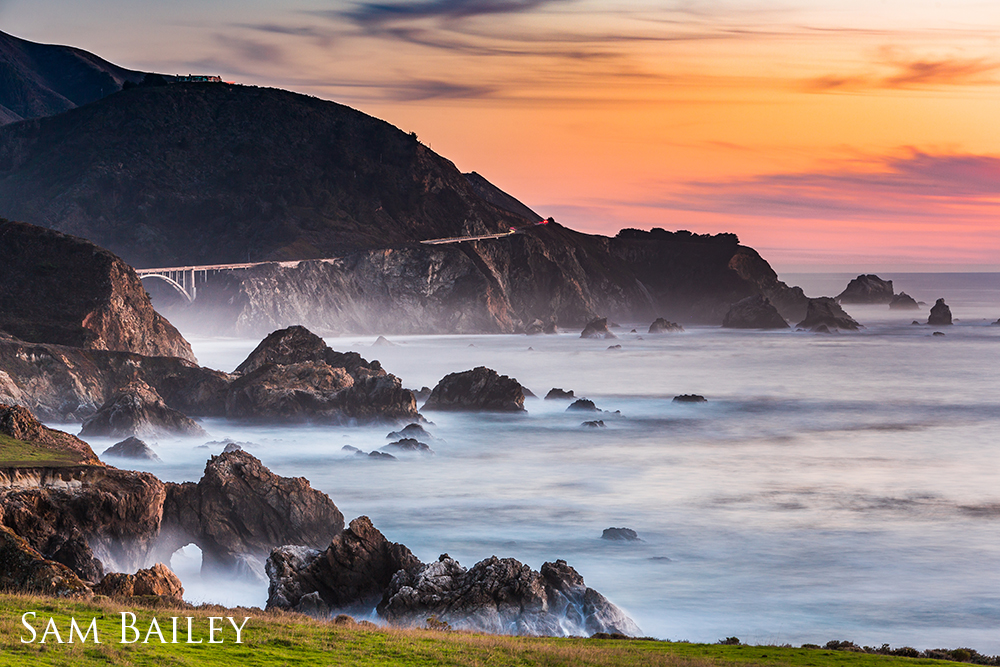Seasons in the Sanctuary

Year-round, Monterey Bay National Marine Sanctuary harbors incredible marine life, including at least 36 species of marine mammals, 180 species of seabirds and shorebirds, 525 species of fishes, and an abundance of invertebrates and algae. Find out what wildlife you might see during different seasons of the year!
Winter
Northern elephant seals (Mirounga angustirostris) arrive at their breeding rookeries, some of the largest at Año Nuevo State Reserve and Piedras Blancas. Adult males (bulls) arrive in December and fight with each other for dominant positions. Females arrive in December and the first pup is usually born mid-month. Pupping peaks in mid-January.
Look for the blows of gray whales (Eschrichtius robustus) migrating south through the sanctuary in December and February. Pregnant females come first, visible from shore as they head for the warm waters off of Baja California, Mexico for calving and mating.
Most southern sea otter (Enhydra lutris nereis) pups are born between January and March in the sanctuary, although there is another pupping peak in the fall.
The peak season for watching migrating shorebirds and seabirds is December through February as they follow the Pacific Flyway southward, stopping in coastal areas to rest and feed. Surfbirds (Aphriza virgata) and black turnstones (Arenaria melanocephala) are common in rocky areas throughout the winter months.
As early as January, flocks of surf scooters (Melanitta perspicillata) float just outside the wave zone. By the end of April, however, they will head towards their nesting areas in Canada and Alaska.
Offshore visitors include sooty (Ardenna grisea) and short-tailed (Ardenna tenuirostris) shearwaters, Laysan albatross (Phoebastria immutabilis), Cassin's (Ptychoramphus aleuticus) and rhinoceros (Cerorhinca monocerata) auklets, red phalaropes (Phalaropus fulicaria), and ancient murrelets (Synthliboramphus antiquus).

Spring
Female Pacific harbor seals (Phoca vitulina richardsi) give birth to pups from February to June and can be seen along sheltered areas such as the beach west of Hopkins Marine Station, at Point Lobos State Natural Reserve, and along Moonstone Beach.
The northward gray whale (Eschrichtius robustus) migration begins in the spring, as cow-calf pairs make their northward journey from Baja California, Mexico to Alaska. Cow–calf pairs can be seen nearshore March through May.
By mid–March most of the adult northern elephant seals (Mirounga angustirostris) have returned to sea to feed, leaving the pups behind on beaches to fend for themselves. By late April most of the weaned pups have gone to sea to begin feeding.
Humpback whales (Megaptera novaeangliae) start arriving in March to feed on large schools of anchovies or krill in the nutrient-rich waters and can be seen throughout the summer into November.
By late March, Brandt's cormorants (Urile penicillatus) gather at nesting areas along the rocky coast and can be seen performing their distinctive mating rituals, bobbing their heads and craning their necks up and back.
Listed as a threatened species and protected by the federal Endangered Species Act, the western snowy plover (Anarhynchus nivosus nivosus) breeds and nests from April through August. Individual nest or larger nesting areas may be fenced or delineated by signs to keep visitors away.
Offshore visitors can include pigeon guillemots (Cepphus columba), black-footed albatross (Phoebastria nigripes), arctic terns (Sterna paradisaea), and Sabine's gulls (Xema sabini).

Summer
Blue whales (Balaenoptera musculus), the largest living animal on the planet, arrive in the offshore waters of the sanctuary to feed on krill. They continue their migration south to wintering grounds in Mexico and Central America.
Adult northern elephant seals (Mirounga angustirostris) can be spotted along isolated beaches from April to August as they undergo catastrophic molting (shedding of fur).
Endangered western Pacific leatherback turtles (Dermochelys coriacea) spend summers along the West Coast to feed on jellies that occur in great numbers. After the summer feeding season, leatherbacks travel 7,000 miles across the Pacific to return to their nesting beaches in Indonesia.
From May to August, black oystercatcher (Haematopus bachmani) mating pairs will guard their intertidal territory and their nests from predators. Chicks hatch and fledge along the rocky coast, and are vulnerable to human disturbances, so give them plenty of space along the shore.
Brown pelicans (Pelecanus occidentalis) arrive in large numbers from Southern California and Mexico, following the northward migration of anchovies and sardines.

Fall
Although seen year round, the peak time for spotting California sea lions (Zalophus californianus) is the fall, when adults (mostly males) return from their breeding grounds on islands off Southern California (Channel Islands) and Baja, Mexico.
Although seen year round, several species of dolphins, including long-beaked common (Delphinus capensis), Risso's (Grampus griseus), and Pacific white-sided (Lagenorhynchus obliquidens) are more abundant in August and September.
Shorebirds migrate southward to the central coast after leaving their breeding grounds in Alaska, the Arctic, and the northern plains. Many of these birds, including least sandpipers (Calidris minutilla), black-bellied plovers (Pluvialis squatarola), willets (Tringa semipalmata), marbled godwits (Limosa fedoa), eared grebes (Podiceps nigricollis), common loons (Gavia immer), and California gulls (Larus californicus), will spend the winter on the central coast.
Offshore visitors include sooty (Ardenna grisea), pink-footed (Ardenna creatopus), flesh-footed (Ardenna carneipes), and Buller's shearwaters (Ardenna bulleri) in Monterey Bay during September. The beginning of September is the best time to see large numbers of arctic terns (Sterna paradisaea), Sabine’s gulls (Xema sabini), and long-tailed jaegers (Stercorarius longicaudus).


